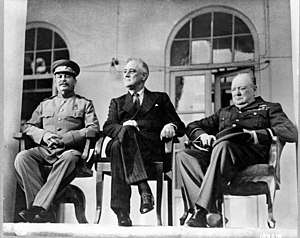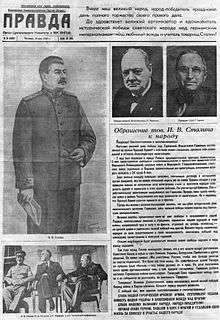Grand Alliance (World War II)
The Grand Alliance (German: Anti-Hitler-Koalition), also known as The Big Three, was a military alliance consisting of the three major Allies of World War II: the Soviet Union, the United States, and the United Kingdom. It is often called the "Strange Alliance" because it united the world's greatest capitalist state, the greatest Communist state and the greatest colonial power.[1] The Declaration by United Nations on New Year's Day in 1942, signed by 26 different nations, not only laid the groundwork for the future of the United Nations, but officially formed the Grand Alliance, committing the three nations to cooperation until the culmination of the war.[2]


Origins
The Grand Alliance was one of convenience in the fight against the Axis powers. The British had reason to ask for one as Germany, Italy, and Imperial Japan threatened not only the colonies of the British Empire in North Africa and Asia, but also the British mainland. The United States felt that the Japanese and German expansion should be contained, but ruled out force until the attack by the Imperial Japanese Navy on Pearl Harbor on 7 December 1941. The Soviet Union, after the breaking of the Nazi–Soviet Pact by the instigation of Operation Barbarossa in 1941, greatly despised the unchallenged Japanese expansion in the East, particularly considering their defeat in several previous wars with Japan. They also recognized, as the US and Britain had suggested, the advantages of a two-front war. In 1942 the three powers discussed becoming, with China, the Four Policemen of world peace.
Before official confirmation of the alliance, there had been pre-emptive vision of a postwar world. With the Atlantic Charter, seeking to define a common Anglo-American vision of the postwar world, there was evidence to collaboration before the official forming of alliance.[3] Similarly, US aid in the form of Lend-Lease provided a basis for the potential alliance to transpire.
Tensions
There were many tensions in the Grand Alliance among the "Big Three" leaders Franklin D. Roosevelt, Winston Churchill, and Joseph Stalin, although they were not enough to break the alliance during wartime. Division emerged over the length of time taken by the Western Allies to establish a second front in Europe.[4] Stalin and the Soviets used the potential employment of the second front as an 'acid test' for their relations with the Anglo-American powers.[5] The Soviets were forced to use as much manpower as possible in the fight against the Germans, whereas the United States had the luxury of flexing industrial power, but with the 'minimum possible expenditure of American lives.'[5] Roosevelt delayed until 1944 to enforce a second front in Europe; in the meantime he had endorsed the British proposal to invade North Africa, straining Anglo-American and Soviet relations.
The essential ideological differences between the United States and the Soviet Union strained their relationship. Tensions between the two countries had existed for decades, with the Soviets remembering America's participation in the armed intervention against the Bolsheviks in the Russian Civil War as well as its long refusal to recognize the Soviet Union's existence as a state. The original terms of the Lend-Lease loan were amended towards the Soviets, to be put in line with British terms. The United States would now expect interest with the repayment from the Soviets, following the initiation of the Operation Barbarossa, at the end of the war - the United States were not looking to support any 'postwar Soviet reconstruction efforts'[6], which eventually manifested into the Molotov Plan. During the meetings from 1943-45 there were disputes over the growing list of demands from the USSR. Tensions increased further when Roosevelt died and his successor Harry Truman rejected demands put forth by Stalin.[4] Roosevelt understood that 'cultural differences could doom the alliance' and as opposed to the likes of Truman and W. Averell Harriman, Roosevelt wanted to play down these tensions.[7] Roosevelt felt he 'understood Stalin's psychology' which aided him in cooperating more successfully with the Soviet Union in comparison to Truman, stating 'Stalin was too anxious to prove a point... he suffered from an inferiority complex.'[8]
See also
- Tehran Conference (codename "Eureka") - 1st meeting of "The Big Three" heads of state (28 Nov - 1 Dec 1943)
- Yalta Conference (codename "Argonaut") - 2nd meeting of "The Big Three" heads of state (4 - 11 Feb 1945)
- Potsdam Conference (codename "Terminal") - 3rd and final meeting of "The Big Three" heads of state during WWII (Truman having taken over for FDR, 17 Jul - 2 Aug 1945)
- List of Allied World War II conferences
References
- Ambrose, Stephen (1993). Rise to Globalism: American Foreign Policy Since 1938. New York: Penguin Books. p. 15.
- Ninkovich, Frank (1999). The Wilsonian Century: US Foreign Policy since 1900. Chicago: Chicago University Press. p. 137.
- Ninkovich, Frank (1999). The Wilsonian Century: US Foreign Policy since 1900. Chicago: Chicago University Press. p. 131.
- Jones, Maldwyn (1983). The Limits of Liberty: American History 1607-1980. Oxford: Oxford University Press. p. 505.
- Gaddis, John Lewis (2000). The United States and the Origins of the Cold War, 1941-1947. New York. p. 65.
- Gaddis, John Lewis (2000). The United States and the Origins of the Cold War, 1941-1947. New York. pp. 178–179.
- Costigliola, Frank (2010). "'After Roosevelt's Death: Dangerous Emotions, Divisive Discourses and the Abandoned Alliance'". Diplomatic History. 34 (1): 19 – via JSTOR.
- Costigliola, Frank (2010). "'After Roosevelt's Death: Dangerous Emotions, Divisive Discourses and the Abandoned Alliance'". Diplomatic History. 34 (1): 7–8 – via JSTOR.
- Winston Churchill. The Grand Alliance. Re-issued by Houghton Mifflin Harcourt, 1986. ISBN 978-0-395-41057-8.